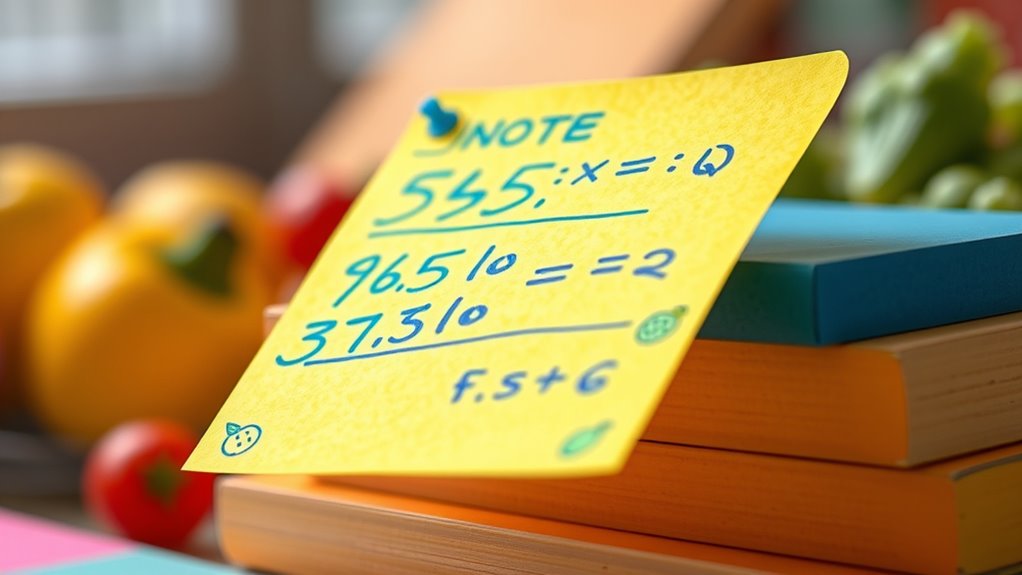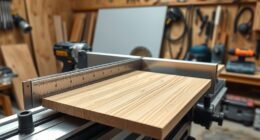You can manage essential shop math with simple sticky notes by tracking your total sales and costs to easily calculate profit margins on the spot. You can also record your inventory values and sales to determine inventory turnover rates visually. Using sticky notes makes these calculations quick, portable, and easy to update, helping you stay aware of your business health in real time. Keep exploring, and you’ll discover even more ways to streamline your shop math practices.
Key Takeaways
- Calculate gross profit by subtracting COGS from total sales using sticky notes.
- Track inventory turnover by comparing beginning inventory and sales figures side by side.
- Use notes to monitor profit margins quickly, aiding pricing decisions.
- Visualize sales patterns and inventory levels to optimize stock management.
- Keep essential business metrics in plain sight for real-time decision-making.

If you’re looking for a simple way to keep track of your shopping expenses, using sticky notes for shop math can be surprisingly effective. Whether you’re managing a small retail space or just keeping tabs on personal spending, sticky notes offer a quick, visual method to perform essential calculations. One of the most important calculations you’ll want to master is understanding your profit margins. By jotting down your total sales and subtracting the cost of goods sold (COGS), you can quickly see your profit per sale. Write your sales figure on one sticky note, then add your COGS on another, and subtract to find your gross profit. This simple step helps you gauge whether your pricing strategy is sustainable or if you need to adjust prices to improve profitability. Regularly assessing and adjusting your pricing based on these calculations can help optimize your profit margins and overall business health.
Another key area where sticky notes shine is tracking inventory turnover. This metric indicates how fast you’re selling your stock and replenishing it, which directly impacts your cash flow and profitability. To do this on sticky notes, note the beginning inventory value at the start of a period and then track the total sales or units sold during that same period. Place these notes side by side, then divide the total sales by the average inventory to get your turnover rate. Doing this visually on sticky notes allows you to see patterns over time—perhaps certain products move faster, signaling you should reorder more frequently or focus on those items. Keeping this information accessible on sticky notes makes it easier to adjust your stock levels proactively, avoiding overstocks or stockouts.
Using sticky notes for these calculations isn’t just about convenience; it encourages a hands-on approach to shop math. Instead of relying solely on spreadsheets or software, you’re engaging directly with your numbers, which can deepen your understanding of your business dynamics. Plus, sticky notes are portable and can be placed in strategic spots—near your cash register, stock area, or workspace—serving as constant reminders or quick reference points. This visual aspect helps you stay aware of your profit margins and inventory turnover in real time, leading to smarter decisions and healthier margins.
In the end, the beauty of shop math on sticky notes is its simplicity and immediacy. You don’t need complex formulas or digital tools to get a clear picture of your business health. With just a few notes, you keep essential metrics in sight, making it easier to respond quickly and keep your shop profitable. Mastering these basic calculations will give you a solid foundation to grow and sustain your business efficiently.
Frequently Asked Questions
Can Sticky Note Math Help With Larger or Complex Store Transactions?
Sticky note math can definitely help with large transactions and complex calculations. When you’re managing multiple items, discounts, or taxes, quick calculations keep you accurate and efficient. Using a sticky note allows you to jot down key numbers and perform simple math on the spot, reducing errors. This instant approach helps you handle large transactions smoothly, saving time and ensuring your calculations stay precise, even during busy store hours.
What Tools or Supplies Are Best Besides Sticky Notes for Shop Math?
When tackling shop math beyond sticky notes, you should consider tools like calculator apps and accounting spreadsheets. Calculator apps provide quick, accurate calculations, especially for complex transactions. Accounting spreadsheets help you track inventory, sales, and expenses efficiently. These tools streamline your math tasks, reduce errors, and save time. Combining them with sticky notes for quick reminders creates a powerful system to manage shop math effectively.
How Accurate Is Sticky Note Math Compared to Digital Calculations?
Imagine sticky notes as tiny pirates charting a treasure map—adventurous but sometimes a bit wayward. Your sticky note math can be surprisingly quick for basic tasks, but it isn’t always precise. While it offers rapid calculation speed, pricing accuracy can suffer with complex figures or multiple steps. Digital calculations, like a trusty compass, provide more reliable precision, ensuring you don’t lose your way in the numbers.
Can Sticky Note Methods Be Used for Inventory Management?
You can definitely use sticky note methods for manual inventory and stock tracking. By jotting down counts and updates on sticky notes, you keep a quick, visual record of stock levels, making it easy to spot shortages or surpluses at a glance. This simple approach helps you stay organized without needing digital tools, especially in small shops or when digital systems aren’t available. Just guarantee regular updates for accuracy.
Are There Specific Types of Sticky Notes Recommended for Shop Math?
Did you know that 85% of small shop owners find quick calculations essential? When it comes to shop math, you should choose sticky notes with a smooth, writable surface similar to chalkboard calculations. Use a notepad essentials approach, opting for sticky notes that are durable and easy to write on, like those with a matte finish. These help you keep accurate, quick calculations without the fuss of traditional notepads.
Conclusion
Next time you step into a shop, let a sticky note be your secret weapon. Imagine jotting down quick calculations as your hands move swiftly, turning cluttered counters into a canvas of confidence. Each note becomes a small anchor of clarity, guiding you smoothly through your shopping. With just a simple sticky note, you transform chaos into calm, empowering you to make smarter choices and leave the store feeling victorious, ready to conquer anything that comes next.









